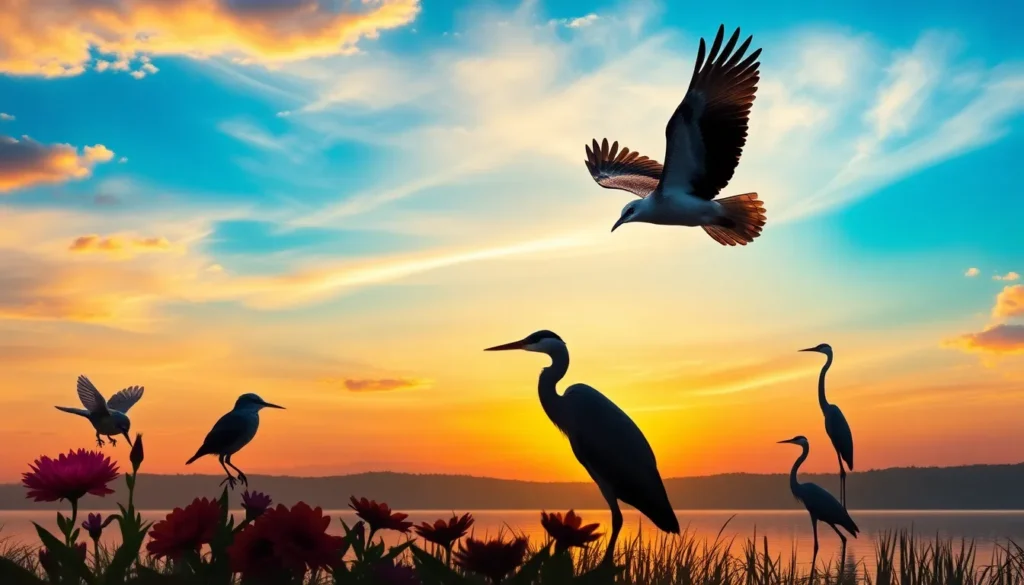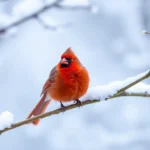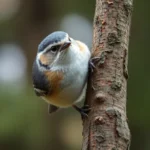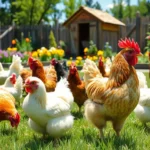Bird silhouettes capture nature’s most graceful forms in their purest essence. Whether you’re spotting a majestic eagle soaring overhead or watching a tiny hummingbird dart between flowers, these distinctive outlines help us identify our feathered friends from remarkable distances.
We’ve all experienced that magical moment when a bird’s shadow dances across our path or when we glimpse an unmistakable shape against the evening sky. Understanding bird silhouettes transforms ordinary moments into exciting wildlife discoveries and opens up a whole new dimension of birdwatching.
From the elegant curves of a swan’s neck to the pointed wings of a falcon in flight, each species displays unique characteristics that make identification possible even when details aren’t visible. Learning to recognize these shapes enhances our connection with nature and turns every outdoor adventure into an opportunity for discovery.
Understanding Bird Silhouette Basics and Why They Matter
Building on the joy of spotting birds in nature, understanding silhouette fundamentals transforms casual observation into skilled identification.
What Makes a Bird Silhouette Distinctive
Overall body proportions create the most recognizable features in bird silhouettes. We notice how a great blue heron’s elongated neck contrasts sharply with a robin’s compact, rounded frame. Wing positioning during flight reveals species-exact patterns like the distinctive V-shape of turkey vultures versus the flat-winged glide of red-tailed hawks.
Posture variations help us distinguish between similar-sized species. Woodpeckers maintain upright stances on tree trunks while nuthatches often hang head-down. Tail length and shape provide additional clues, from the deeply forked swallow tail to the fan-shaped turkey tail display.
Size relationships between body parts create unique profiles. Cardinals show thick, seed-cracking bills that appear oversized for their heads, while warblers display thin, insect-catching beaks that seem almost delicate.
Key Body Parts That Define Bird Shapes
Head shapes vary dramatically across species and feeding behaviors. Raptors like hawks showcase broad heads with pronounced curves, while finches display rounded heads perfectly proportioned for their compact bodies. Bill variations immediately signal dietary preferences, from the needle-thin hummingbird bill to the massive pelican pouch.
Wing configurations change based on flight patterns and habitat needs. Soaring birds like eagles maintain broad, rectangular wings, while fast fliers such as falcons show pointed, swept-back wing shapes. Neck length ranges from the barely visible songbird neck to the S-curved elegance of herons and egrets.
Leg proportions reflect lifestyle adaptations we can spot in silhouettes. Shorebirds like stilts showcase extremely long legs for wading, while perching birds maintain shorter, grasping legs suited for branch life.
How Lighting Conditions Affect Bird Silhouettes
Backlighting scenarios create the clearest silhouettes when birds position themselves between us and bright light sources. Morning and evening hours produce optimal backlighting conditions, transforming birds into perfect dark shapes against luminous skies. Overcast conditions provide even lighting that reveals subtle shape details while maintaining strong contrast.
Sun positioning changes throughout the day, affecting silhouette clarity and visibility angles. We get the sharpest profiles when the sun sits directly behind our subjects, eliminating distracting shadows and color variations.
Seasonal lighting impacts silhouette observation opportunities as daylight hours shift. Winter months offer longer periods of low-angle sunlight ideal for backlighting, while summer’s high sun creates fewer optimal silhouette moments during midday hours.
Shadow effects can either enhance or obscure bird shapes depending on surface positioning. Birds perched on elevated branches cast cleaner silhouettes than those near ground level where competing shadows create visual confusion.
Identifying Common Backyard Bird Silhouettes
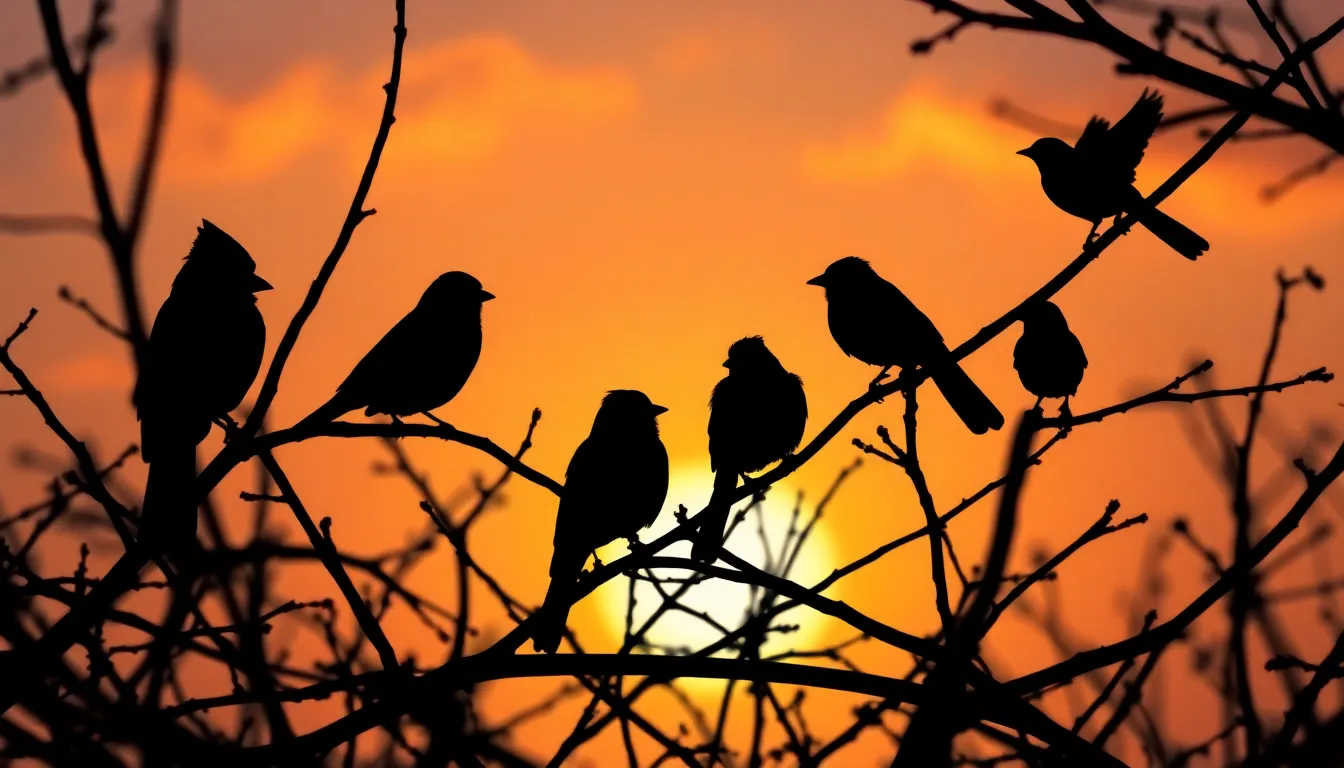
We’ll examine the most frequently spotted backyard bird silhouettes to help you quickly recognize these feathered visitors from a distance.
Robin and Thrush Silhouette Characteristics
Robins display a classic songbird silhouette with their rounded head and relatively long legs for ground foraging. Their upright posture when perched creates a distinctive triangular body shape that tapers from the breast to the tail. We notice their medium length tail that appears proportional to their body size.
Thrushes share similar proportions but show a slightly more elongated appearance overall. Their heads appear rounder than robins, and they maintain a more horizontal posture when perched on branches. Wood thrushes and hermit thrushes exhibit longer tails relative to their body size compared to their robin cousins.
Both species demonstrate similar wing shapes during flight, with broad rounded wings that create steady, undulating flight patterns. Their silhouettes become most distinguishable when they’re feeding on the ground, as robins hop with an upright stance while thrushes tend to move in a more crouched position.
Cardinal and Finch Shape Differences
Cardinals stand out immediately with their prominent crest that creates a distinctive peaked head silhouette. Their robust, cone shaped bills appear oversized compared to their head, giving them a top heavy appearance when viewed in profile. Males and females share identical silhouettes even though their dramatic color differences.
Finches present a more compact, rounded silhouette with smaller proportional heads and shorter tails. House finches and purple finches show similar body shapes, but goldfinches appear noticeably smaller with more delicate proportions. Their bills create tiny triangular points that barely extend beyond their head outline.
Flight silhouettes reveal dramatic differences between these species. Cardinals fly with slow, steady wingbeats and their crest remains visible even in flight. Finches exhibit bouncing flight patterns with rapid wingbeats followed by brief wing closures, creating a distinctive undulating path through the air.
Sparrow and Wren Size Variations
Sparrows cover a wide range of sizes from the tiny chipping sparrow to the robust white throated sparrow. House sparrows show medium proportions with rounded heads and sturdy bills, while song sparrows appear more elongated with longer tails that they often cock upward when perched.
Wrens consistently maintain compact, round body shapes regardless of species size. Carolina wrens and house wrens both display short, slightly upturned tails that they frequently hold erect above their backs. Their bills appear thin and pointed, perfectly adapted for insect hunting in tight spaces.
Size comparisons become most apparent when these species feed together at backyard feeders. White crowned sparrows tower over house wrens, while chipping sparrows appear similar in size to most wren species. Their different feeding behaviors also create distinct silhouette patterns, with sparrows scratching on the ground and wrens climbing vertically on tree trunks and branches.
Recognizing Raptor Bird Silhouettes in Flight
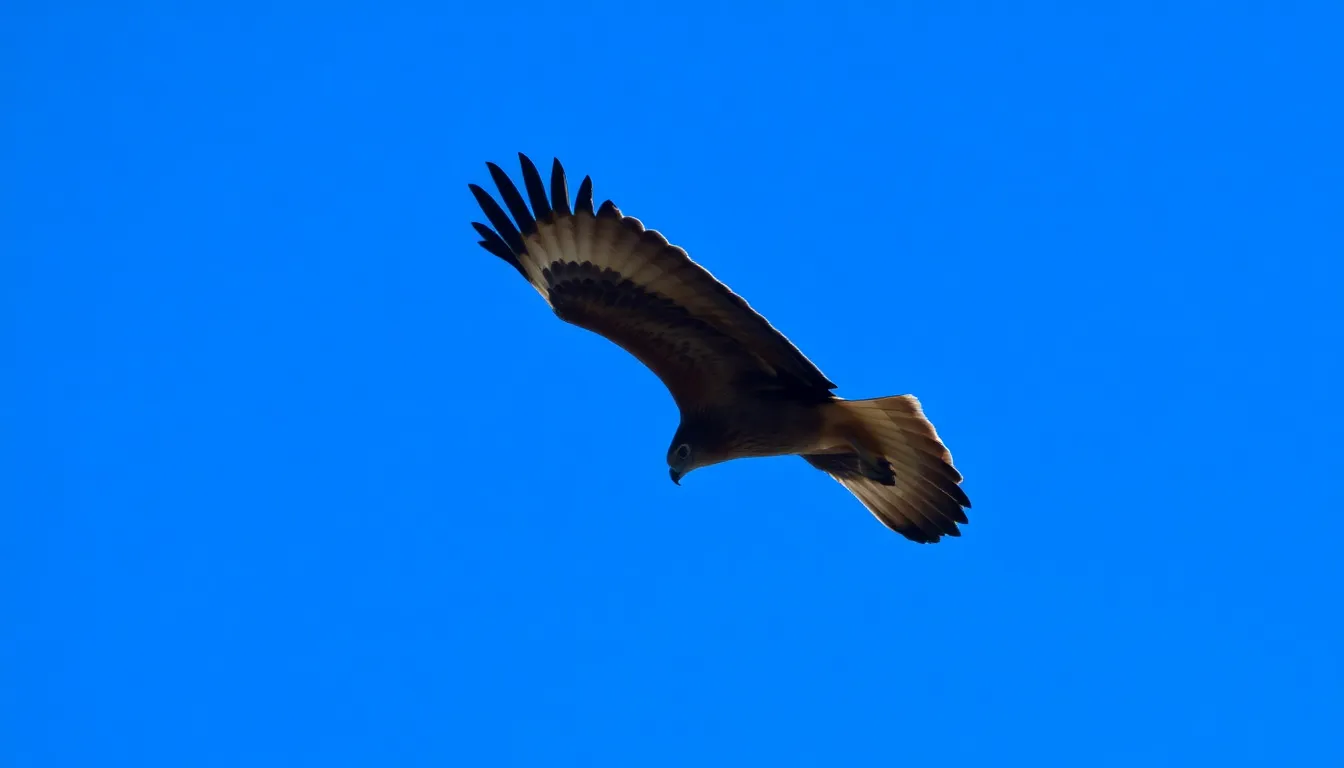
Raptors present some of the most distinctive bird silhouettes in flight, with their predatory adaptations creating unmistakable profiles against the sky. We’ll examine three major raptor groups to help identify these magnificent hunters during our outdoor observations.
Hawk Silhouette Wing and Tail Features
Hawks display broad wings with rounded tips that create a distinctive rectangular appearance when soaring. Their tails typically appear short to medium length with a squared or slightly rounded end, giving them excellent maneuverability through wooded areas. We notice red-tailed hawks maintain their wings in a shallow V-shape called a dihedral, while Cooper’s hawks show straighter wing positioning with more pronounced finger-like wingtip feathers.
Broad wings allow hawks to ride thermals efficiently, creating that classic soaring silhouette we observe during midday hours. Sharp-shinned hawks exhibit shorter, more rounded wings compared to their larger Cooper’s hawk cousins, making size comparison crucial for accurate identification. Wing flapping patterns distinguish hunting hawks from soaring ones, with active hunters showing quicker, more erratic flight movements.
Eagle Wingspan and Head Proportions
Eagles possess the largest wingspans among our common raptors, with bald eagles reaching spans of 6 to 7.5 feet that create impressive rectangular silhouettes. Their heads project prominently forward from their bodies, appearing larger and more substantial than hawk proportions. We observe golden eagles maintaining flatter wing positions during soaring, while bald eagles often hold their wings in a more pronounced upward angle.
Mature bald eagles show distinctive white head and tail contrasts that become visible even at considerable distances. Juvenile eagles appear uniformly dark brown, requiring us to rely on size and proportional differences for identification. Wing loading differences make eagles appear to soar more effortlessly than smaller raptors, with fewer wingbeats needed to maintain altitude.
Falcon Body Shape and Flight Patterns
Falcons exhibit sleek, streamlined silhouettes with long, pointed wings that distinguish them immediately from other raptor groups. Their wings appear narrow and swept back, creating a crescent or anchor shape that’s perfectly adapted for high-speed flight. We notice peregrine falcons maintaining rapid wingbeat patterns interspersed with brief glides, creating a distinctive hunting flight profile.
American kestrels show the smallest falcon silhouette with proportionally longer tails and more hovering behavior than their larger relatives. Merlin falcons demonstrate direct, powerful flight with steady wingbeats that rarely include the soaring behavior we see in hawks and eagles. Flight speed becomes our most reliable identification tool, as falcons consistently outpace other raptors during active hunting sequences.
Distinguishing Waterbird Silhouettes by Habitat
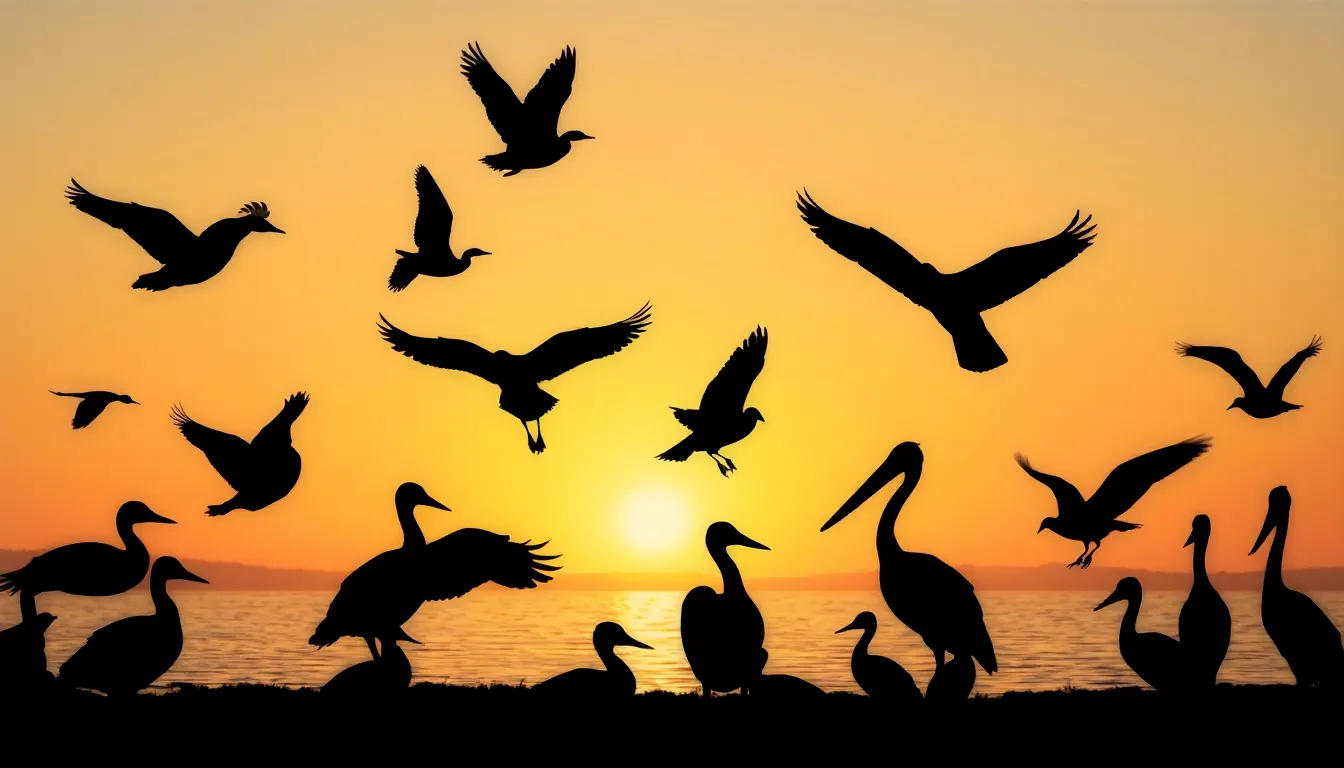
Water environments reveal distinct bird silhouette patterns that help us identify species based on their preferred habitats. Different waterbirds have evolved specialized body shapes that reflect their feeding strategies and ecological niches.
Duck and Goose Silhouette Variations
Dabbling ducks create compact, low-profile silhouettes when floating on ponds and marshes. We can recognize mallards and wood ducks by their rounded bodies and relatively short necks compared to other waterfowl. Diving ducks like canvasbacks and ring-necked ducks appear more streamlined with their bodies sitting lower in the water.
Geese display elongated neck silhouettes that extend well above their body mass. Canada geese show distinctive S-curved neck positions when feeding or alert, while their bulkier bodies create triangular shapes during flight. Snow geese present cleaner, more angular silhouettes with straighter neck lines and pointed wing tips.
Swimming patterns also influence waterbird silhouettes we observe. Surface feeders maintain horizontal body positions with tails often visible above water. Diving species create more vertical silhouettes as they tip forward to submerge their heads and necks.
Heron and Egret Neck and Leg Proportions
Great blue herons create the most recognizable wading bird silhouettes with their extremely long necks and legs. We identify them by their S-shaped neck curve when hunting and their ability to extend their necks to nearly double their body height. Their wingspan creates broad, slow-moving flight silhouettes with necks folded back against their bodies.
Egrets share similar proportions but appear more delicate in their overall build. Great egrets match herons in height but display thinner neck profiles and more graceful movement patterns. Snowy egrets present much smaller silhouettes with proportionally shorter legs and necks than their larger cousins.
Feeding behaviors create distinct silhouette variations among these wading birds. Motionless hunting positions show extended neck silhouettes, while active feeding creates ever-changing shapes as birds strike at prey. Flight silhouettes compress these proportions dramatically as long necks fold backward and legs trail behind bodies.
Pelican and Cormorant Wing Shapes
Brown pelicans produce unmistakable flight silhouettes with their massive wingspans and distinctive bill pouches. We recognize their gliding patterns over coastal waters by their steady, straight-line flight paths and infrequent wing beats. Their landing approaches create dramatic silhouettes as they fold their wings just before hitting the water.
Cormorants display different wing proportions that create more angular flight silhouettes. Double-crested cormorants show narrower wings relative to their body size compared to pelicans. Their swimming silhouettes appear lower in the water with just heads and curved necks visible above the surface.
Drying behaviors create characteristic perching silhouettes for these waterbirds. Cormorants spread their wings wide in distinctive cruciform poses to dry their feathers after diving. Pelicans create bulkier perching silhouettes with their large bills and rounded bodies clearly visible on posts and rocks.
Spotting Songbird Silhouettes Through Seasonal Changes
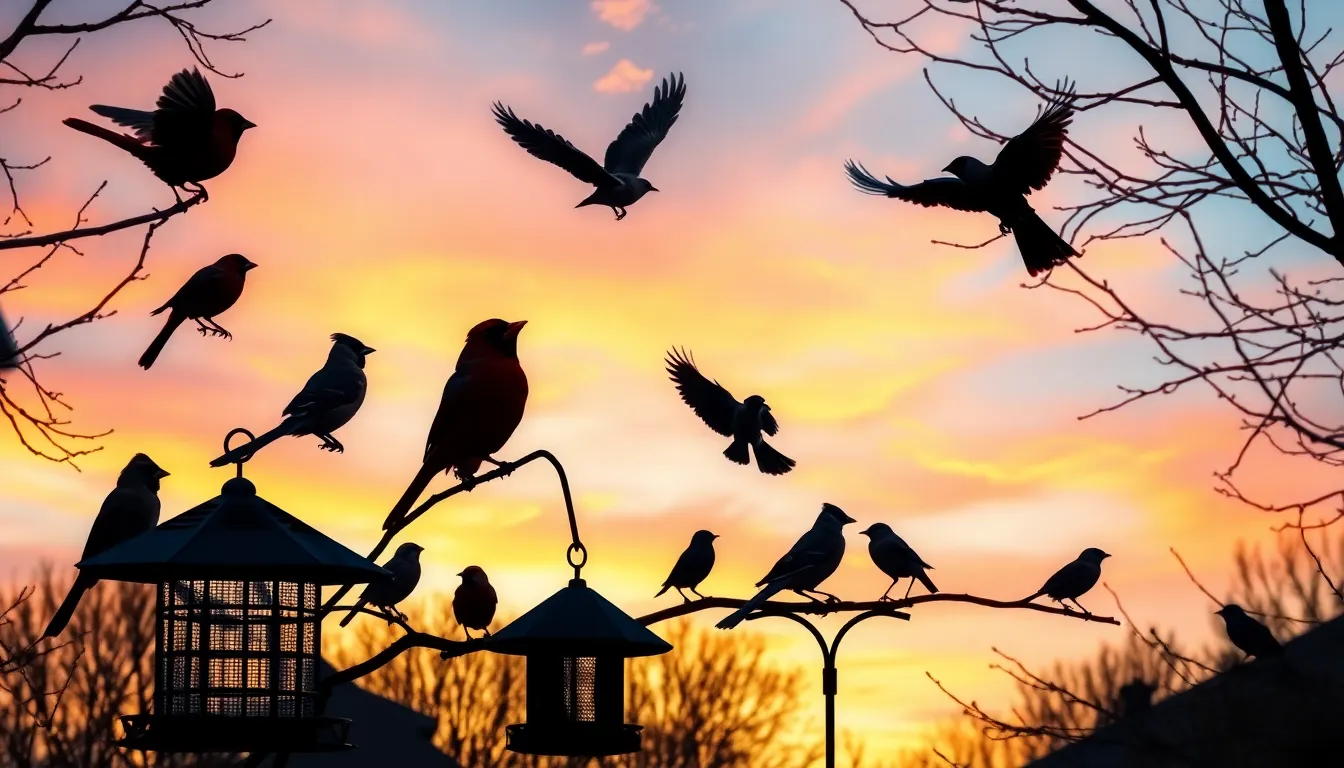
Seasonal transformations dramatically affect how we observe and identify songbird silhouettes throughout the year. Weather patterns, food availability, and behavioral changes create distinct opportunities for recognizing different species based on their characteristic shapes.
Winter Feeding Station Silhouette Identification
Winter feeding stations concentrate songbirds in predictable locations, creating ideal conditions for studying their silhouettes. Cardinals appear most dramatically during snowy conditions, their prominent crests and thick bills creating unmistakable profiles against white backgrounds. Northern mockingbirds display elongated tails and slender builds while perched on feeder poles, often flicking their tails in distinctive patterns.
Juncos cluster beneath feeders in small flocks, their compact rounded shapes and frequent ground hopping movements making identification straightforward. Blue jays dominate feeding areas with their larger angular silhouettes and distinctive head crests, often appearing in pairs or small groups. Chickadees create tiny spherical shapes that bob and dart between feeder visits, their proportionally large heads making them instantly recognizable.
Nuthatches cling to feeder poles and tree trunks headfirst, their wedge shaped bodies and short tails creating unique downward pointing silhouettes. Woodpeckers visit suet feeders with their characteristic vertical postures, bracing against surfaces with stiff tail feathers while their strong bills work at food sources.
Spring Migration Silhouette Patterns
Spring migration brings waves of songbirds through our viewing areas, each species displaying exact flight and perching patterns. Warblers arrive in mixed flocks during peak migration periods, their small delicate silhouettes flitting rapidly through tree canopies as they search for insects. Yellow rumped warblers show distinctive tail flicking behaviors while perched, creating animated silhouette movements that help distinguish them from similar sized species.
Thrushes migrate primarily at night but appear in gardens and parks during dawn hours, their upright postures and alert head positions creating classic songbird silhouettes. American robins return in large flocks, their triangular flight shapes and bouncing ground movements signaling the arrival of spring migration waves. Vireos move deliberately through branches with slightly hunched postures, their methodical feeding behaviors creating steady silhouette patterns.
Flycatchers perch upright on exposed branches, launching into aerial pursuits that create distinctive flight silhouettes with quick directional changes. Eastern kingbirds display broad shouldered silhouettes with square tipped tails, often hovering momentarily before returning to prominent perches.
Summer Nesting Behavior Silhouette Clues
Summer nesting activities produce unique silhouette observations as songbirds engage in territorial and parental behaviors. Male songbirds claim territory by perching prominently on high branches, fence posts, and utility lines, their alert upright postures creating bold silhouettes against morning and evening skies. Red winged blackbirds display on cattail stems in wetland areas, their spread wing postures and forward leaning stances signaling territorial dominance.
Parent birds carrying food create distinctive flight silhouettes with bills full of insects, worms, or berries, their direct flight paths leading observers to nesting locations. House wrens appear constantly active around nest boxes, their small compact shapes darting in and out of cavities with remarkable frequency. Barn swallows create graceful arcing flight patterns while gathering mud for nest construction, their deeply forked tails and swept back wings producing unmistakable silhouettes.
Fledgling birds create unique identification challenges with their fluffy juvenile silhouettes, often appearing larger and more rounded than their parents while maintaining similar proportions. Adult birds feeding fledglings produce animated silhouette groups as young birds flutter their wings and open their bills in begging displays, creating temporary but recognizable family unit patterns.
Using Technology to Enhance Bird Silhouette Recognition
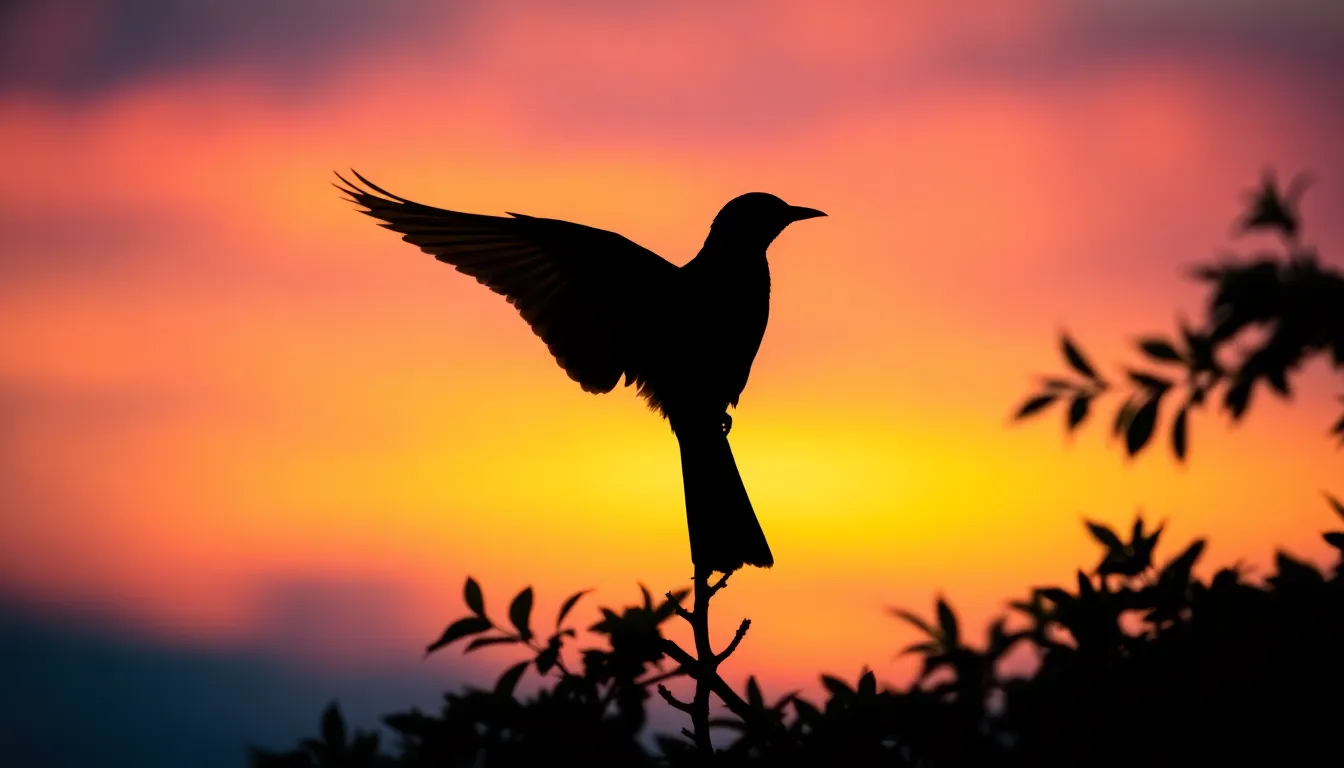
Modern technology transforms how we identify bird silhouettes, offering powerful tools that complement our field observations. Digital answers enhance our recognition skills while building confidence in species identification.
Mobile Apps for Silhouette Identification
eBird serves as our comprehensive platform for logging observations and accessing real-time species data. The app’s location-based features show which species we’re likely to encounter, helping narrow down silhouette possibilities before heading into the field.
Merlin Bird ID revolutionizes silhouette identification through its photo identification feature. We can capture unclear silhouettes and receive instant species suggestions based on size, shape, and location data. The app’s sound identification complements visual silhouettes when birds vocalize.
iNaturalist connects us with a global community of birders and experts who help verify challenging silhouette identifications. Upload photos of distant or unclear silhouettes, and community members provide species suggestions with explanations of distinguishing features.
BirdNET analyzes audio recordings alongside visual silhouettes, creating a multi-sensory approach to identification. Record bird calls while observing silhouettes to increase identification accuracy, especially for species with similar body shapes.
Camera Settings for Capturing Clear Silhouettes
Exposure compensation becomes crucial when photographing backlit bird silhouettes. We adjust exposure down by 1-2 stops to maintain dark subject details while preserving sky definition behind the bird.
Shutter speed settings of 1/500th second or faster freeze wing positions during flight sequences. Higher speeds capture precise wing angles that reveal species-exact flight patterns essential for accurate silhouette analysis.
Focus modes require careful consideration when shooting silhouettes against bright backgrounds. Single-point autofocus prevents cameras from focusing on background elements instead of the bird’s outline.
RAW file format preserves maximum detail in shadow areas of silhouette images. Post-processing RAW files allows us to adjust contrast and clarity without losing critical shape information.
Telephoto lenses ranging from 300-600mm bring distant bird silhouettes closer while maintaining safe observation distances. Longer focal lengths compress background elements, creating cleaner silhouette separation.
Digital Field Guide Resources
All About Birds by Cornell Lab provides interactive silhouette comparison tools. We can view multiple species side-by-side, comparing wing shapes, tail lengths, and body proportions that distinguish similar species.
Birds of North America Online offers detailed range maps alongside silhouette illustrations. Geographic filtering helps eliminate unlikely species when identifying challenging silhouettes in exact regions.
Audubon Bird Guide features seasonal abundance charts that predict which silhouettes we’re most likely to encounter during different times of year. Migration timing data refines our identification possibilities.
Peterson Field Guide ebook versions allow instant searches for exact silhouette characteristics. Digital guides load faster than physical books and include audio files that complement visual identification.
BirdLife International database provides global distribution maps for species identification beyond North America. International birders can access silhouette resources for species worldwide, expanding identification capabilities during travel.
Creating Artistic Bird Silhouette Photography
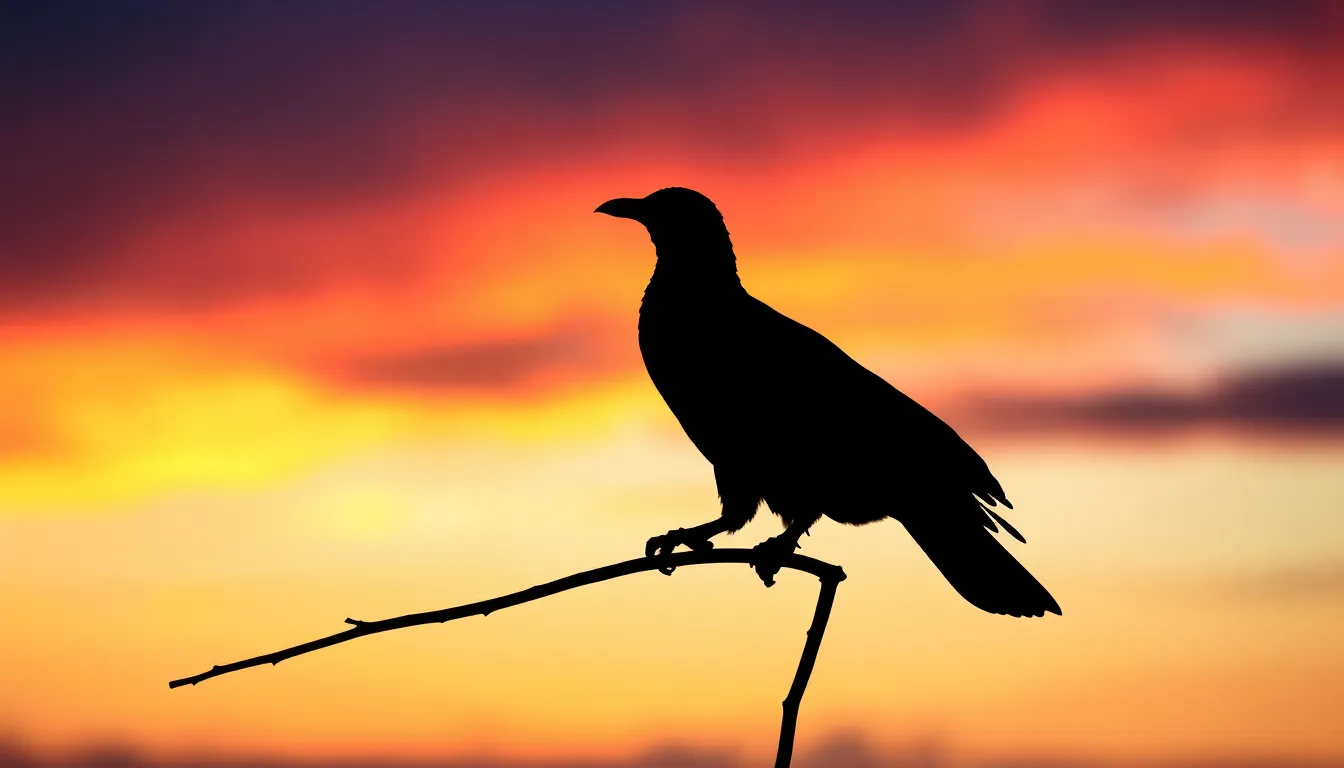
Artistic bird silhouette photography transforms simple wildlife observation into compelling visual storytelling. We’ll explore the technical aspects that elevate bird silhouettes from casual snapshots to professional artwork.
Best Times of Day for Silhouette Shots
Golden hour provides the most dramatic silhouette opportunities, occurring during the first hour after sunrise and last hour before sunset. During these periods, we find the sun positioned low on the horizon, creating ideal backlighting conditions that separate birds from their backgrounds.
Blue hour extends our shooting window by 30 to 45 minutes after sunset, when ambient light remains sufficient for silhouette work. The sky during blue hour produces rich gradient backgrounds ranging from deep purple to soft orange, offering stunning contrast for bird subjects.
Overcast days present unexpected silhouette opportunities when birds perch against bright cloud formations. We often discover that thick cloud cover acts as a natural softbox, creating even illumination that eliminates harsh shadows while maintaining strong subject definition.
Early morning mist and fog create atmospheric silhouettes that add mystery and depth to bird photography. These weather conditions typically occur 2 to 3 hours after sunrise when temperature differences between ground and air reach their peak.
Camera Positioning and Angle Techniques
Low angle positioning places us below the bird’s eye level, creating dramatic silhouettes against expansive sky backgrounds. This technique works particularly well with perching birds on fence posts, tree branches, or utility lines where we can position ourselves several feet below the subject.
Side lighting captures partial silhouettes that reveal intricate feather details while maintaining the dramatic contrast we seek. We achieve this by positioning ourselves perpendicular to the light source, allowing rim lighting to define wing edges and body contours.
Shooting through foreground elements like tall grass or reeds creates layered compositions that add depth to bird silhouettes. These natural frames help isolate subjects while providing contextual information about their habitat preferences.
Distance control affects silhouette impact significantly, with subjects filling 20 to 30 percent of the frame producing the most compelling results. Closer positioning loses background drama, while excessive distance diminishes subject recognition and emotional connection.
Post-Processing Tips for Dramatic Effects
Exposure adjustment forms the foundation of silhouette processing, requiring us to darken shadows completely while preserving highlight detail in background skies. We typically reduce shadow values by 80 to 100 percent while maintaining natural color gradients in brighter areas.
Contrast enhancement separates subjects from backgrounds more definitively, with clarity and texture adjustments adding definition to bird edges without introducing noise. Local adjustments using radial filters help us darken exact areas around subjects while leaving sky tones untouched.
Color grading transforms ordinary silhouettes into artistic statements through strategic temperature and tint modifications. Warming highlights to 3200K while cooling shadows to 7000K creates striking color separation that emphasizes the silhouette effect.
Vignetting adds focus and drama by gradually darkening frame edges, drawing viewer attention toward centrally positioned bird subjects. We apply subtle vignettes at 15 to 25 percent intensity to avoid obvious digital manipulation while improving natural light falloff patterns.
Teaching Children to Recognize Bird Silhouettes
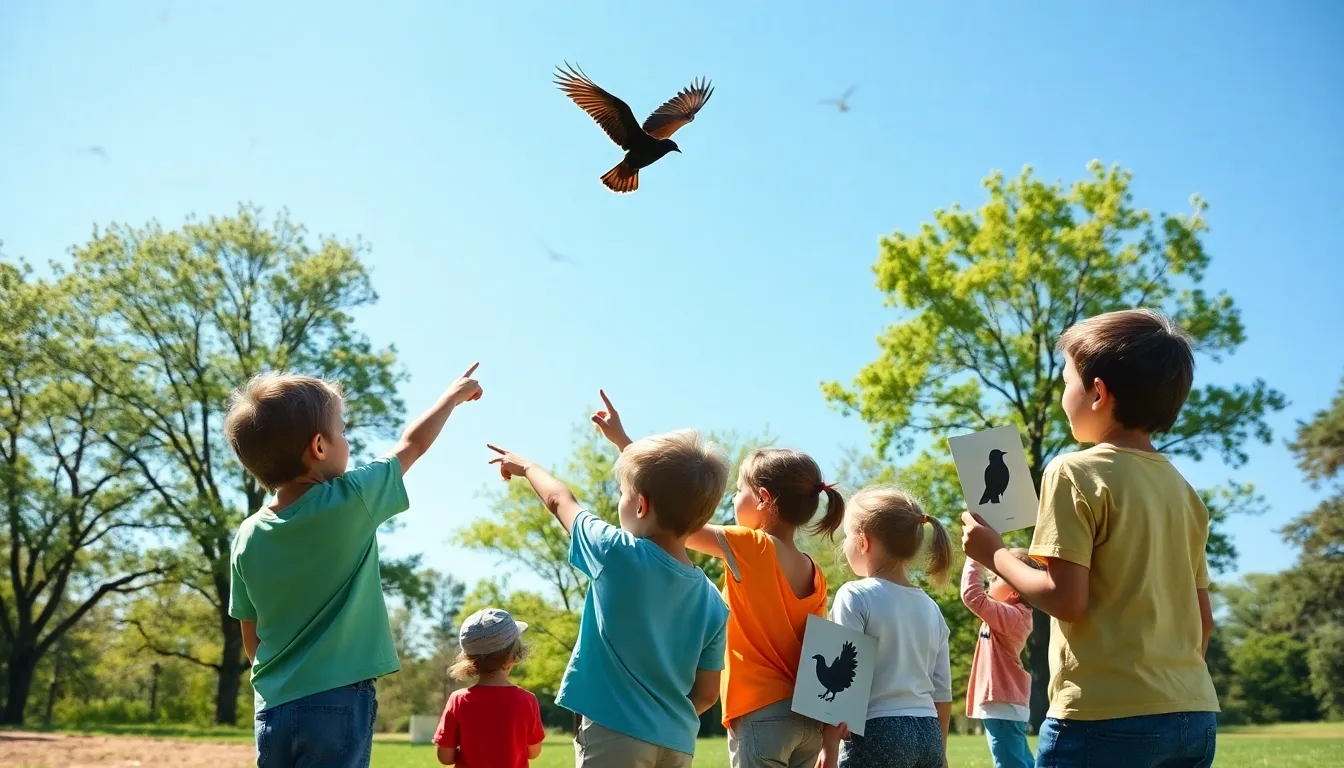
Introducing children to bird silhouette recognition creates lasting connections with nature while building essential observation skills. We’ve found that young minds naturally absorb visual patterns when learning becomes playful and interactive.
Simple Identification Games and Activities
Shadow puppet games transform bird silhouette learning into theatrical entertainment. We encourage children to use their hands to create basic bird shapes against walls or screens, starting with simple forms like ducks, eagles, and hummingbirds. These activities help kids understand how different body proportions create recognizable patterns.
Silhouette matching cards provide structured learning opportunities for visual recognition practice. We create sets featuring common backyard birds like robins, cardinals, and blue jays alongside their corresponding silhouettes. Children can play memory games, concentration, or simple matching exercises that reinforce shape recognition skills.
“Name That Bird” competitions using silhouette flashcards engage multiple children simultaneously. We show black bird outlines for 3-5 seconds and ask participants to identify species based on distinctive features like beak shape, tail length, or wing positioning. This rapid-fire approach builds quick recognition abilities.
Digital silhouette apps offer interactive learning experiences customized for young users. We recommend child-friendly bird identification programs that present silhouettes before revealing colorful bird photos, creating anticipation and reward cycles that maintain engagement.
Drawing Exercises for Memory Building
Trace and create activities help children internalize bird silhouette shapes through muscle memory. We provide outline templates of common species like chickadees, woodpeckers, and hawks that kids can trace repeatedly, gradually building confidence to draw independently.
Progressive drawing challenges start with basic shapes and add complexity over time. We begin with simple oval bodies, then introduce neck variations, wing positions, and tail configurations. Children learn to break down complex silhouettes into manageable geometric components.
Comparison drawing sessions highlight differences between similar species through side-by-side illustrations. We guide children to sketch crow versus raven silhouettes, emphasizing tail shape variations and relative size differences that aid future field identification.
Silhouette journals encourage ongoing practice while documenting learning progress. We suggest children create weekly drawings of observed bird silhouettes, adding notes about location, time of day, and distinctive features that helped with identification.
Nature Walk Silhouette Scavenger Hunts
Checklist adventures transform regular walks into exciting discovery missions. We prepare age-appropriate lists featuring 5-8 common local bird silhouettes, complete with simple illustrations and key identifying features like “long neck” or “pointed wings.”
Photography challenges teach children to capture their own silhouette discoveries using smartphones or tablets. We encourage kids to photograph backlit birds during morning or evening hours, creating personal reference libraries for future study sessions.
Group observation games foster collaborative learning while building social skills. We organize teams of 2-3 children who work together to spot and identify bird silhouettes, sharing discoveries and discussing distinguishing characteristics in real time.
Seasonal tracking activities help children understand how bird populations change throughout the year. We create monthly scavenger hunts focusing on different species, such as winter feeder birds in December or migrating warblers in spring, building awareness of natural cycles.
Time-based challenges add urgency and excitement to silhouette hunting expeditions. We set 15-20 minute windows for finding exact silhouettes, encouraging focused attention while maintaining age-appropriate activity duration for optimal engagement levels.
Conclusion
Bird silhouettes offer us a gateway to deeper wildlife appreciation that transforms every outdoor moment into a discovery opportunity. We’ve explored how these distinctive shapes unlock species identification skills that enhance our connection with nature year-round.
Whether we’re teaching children through playful activities or capturing stunning photography during golden hour the rewards of silhouette recognition extend far beyond basic identification. Modern technology amplifies our capabilities while traditional observation skills remain the foundation of meaningful birdwatching experiences.
The journey from recognizing our first robin’s triangular outline to distinguishing complex raptor flight patterns represents personal growth in wildlife awareness. Every silhouette we learn adds another layer to our understanding of the natural industry around us.
Frequently Asked Questions
What are bird silhouettes and why are they important for birdwatching?
Bird silhouettes are the distinctive outline shapes of birds that allow identification from a distance without seeing detailed features. They’re important because each species has unique proportions, wing shapes, and body characteristics that create recognizable patterns. Understanding silhouettes enhances birdwatching experiences by enabling quick identification during flight or in low-light conditions, deepening our connection with nature.
How do lighting conditions affect bird silhouette visibility?
Backlighting during morning and evening hours creates the clearest silhouettes by positioning birds against bright backgrounds. The golden hour and blue hour provide dramatic silhouette opportunities, while overcast days and early morning mist offer unique visibility conditions. Seasonal changes in daylight hours and sun positioning also influence when optimal silhouette observation opportunities occur throughout the year.
What are the key body parts to focus on when identifying bird silhouettes?
Focus on head shapes, bill variations, wing configurations, tail length, and leg proportions. Head shapes and bills indicate dietary preferences and feeding behaviors, while wing shapes reflect flight patterns and lifestyle adaptations. Body proportions like neck length (elongated in herons vs. compact in robins) and overall frame size help distinguish between species with similar sizes.
Which common backyard birds are easiest to identify by silhouette?
Robins display triangular shapes with distinctive flight patterns, while cardinals show prominent crests and robust bills. Finches appear compact with smaller heads, and sparrows vary in size with unique feeding behavior patterns. Thrushes appear more elongated than robins, and wrens create distinct silhouette variations when observed at feeders, making these species ideal for beginner identification practice.
How can I distinguish between different raptor silhouettes in flight?
Hawks show broad, rectangular wings when soaring with varying tail lengths. Eagles display impressive wingspans with forward-projecting heads, and mature bald eagles show distinctive white head contrasts. Falcons appear sleek and streamlined with high-speed flight patterns. Flight speed and wing positioning are crucial identification factors, as each raptor group has distinct soaring and hunting flight characteristics.
What makes waterbird silhouettes unique from other bird species?
Waterbirds have specialized body shapes reflecting their feeding strategies. Dabbling ducks appear compact, while diving ducks look streamlined. Geese show elongated necks with S-curved shapes, and herons display long necks and legs. Pelicans have massive wingspans with gliding patterns, while cormorants show narrower wings and lower swimming profiles, all adapted to aquatic environments.
How do seasonal changes affect songbird silhouette observation?
Winter feeding stations concentrate songbirds against snowy backgrounds, making identification easier. Spring migration introduces new species with specific flight patterns. Summer nesting creates unique family unit silhouettes as parent birds feed fledglings. Fledgling birds appear larger and fluffier than adults, adding complexity to identification but providing learning opportunities throughout different seasons.
What technology can help with bird silhouette identification?
Mobile apps like eBird, Merlin Bird ID, and iNaturalist provide real-time identification assistance and community support. Digital resources such as All About Birds offer interactive tools and detailed information. Camera settings focusing on exposure compensation, shutter speed, and focus modes help capture clear silhouettes for later identification and documentation purposes.
What are the best techniques for photographing bird silhouettes?
Shoot during golden hour and blue hour for dramatic effects. Use low angle shots and side lighting to enhance silhouette impact. In post-processing, adjust exposure and contrast, apply color grading, and add vignetting for striking visual effects. Overcast days and early morning mist also provide unique photographic opportunities for compelling bird silhouette imagery.
How can I teach children to recognize bird silhouettes?
Use engaging activities like shadow puppet games, silhouette matching cards, and “Name That Bird” competitions. Drawing exercises help children understand bird proportions, while nature walk scavenger hunts provide hands-on experience. Digital apps designed for kids make learning interactive and fun, fostering lasting connections with nature and building essential observation skills for young learners.

